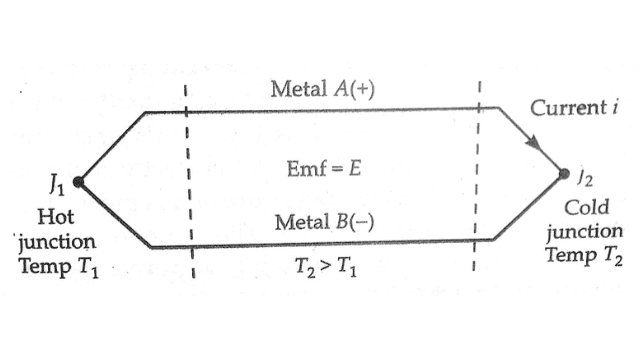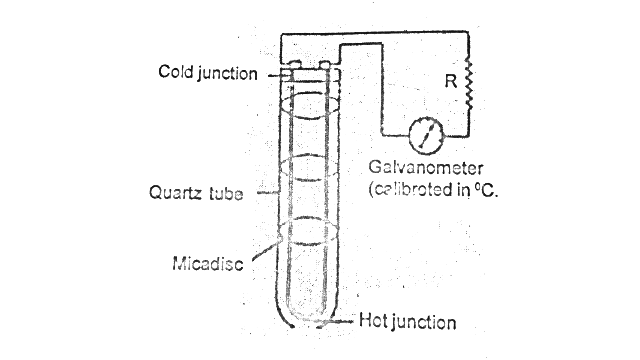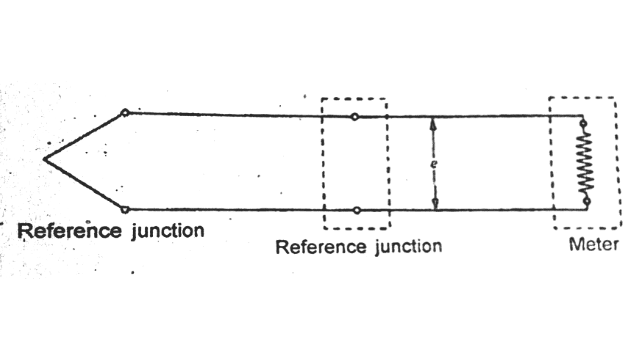
Table of Contents
Thermocouple
A thermocouple is the junction of two dissimilar metals. It is used to measure temperature difference between two points. The material used in junction wires is iron- constantan or sometime it may be copper-constantan which forms the two junctions i.e. hot junction & cold junction. It is based upon the, seebeck effect.
Seebeck Effect
“According to seebeck effect when a conductor is subjected to temperature gradient, it will generated voltage”.
The thermocouple is one of the simplest and most commonly used methods of measuring process temperatures. The operation of thermocouple is based upon seebeck effect. In 1821, seebeck discovered that when heat is applied to junction of two dissimilar metals, an EMF is generated which can be measured at the other Junction. The two dissimilar metals form an electric circuit, and a current flows as a result of the generated EMF.

This current will continue to flow as long as T1>T2. Metal B is described as negative with respect to metal A if current flows into it at the cold junction. The emf produced is function of the difference in temperature of hot and cold junction is given by:
E = aΔΦ
Where ΔΦ = difference between temperatures of hot & cold junctions.
Construction of Thermocouple
Thermocouple consists of a pair of dissimilar metal wires joined together at one end and terminated at the other end which is maintained at a known constant temperature. The junction where the two dissimilar metal wires are joined together is called a hot junction and the other ends of the two wires which are terminated and kept at reference temperature is called cold junction. To ensure long life in its operating environment, thermocouple is provided in a protecting tube. Connections are made by means of special extension wire called compensating wire compensating wire are preferably of the same material as that of thermocouple wire. A typical circuit of an iron-constantan thermocouple.

The deflection shown by meter is directly proportional to the difference in temperatures between hot junction & cold junction. The most common method in thermocouple temperature measurements involves use of potentiometers.
Thermocouple Working Principle
We know that the circuit consists of two dissimilar metals these metals are joined together in such a way that they are creating two junction i.e. one is hot junction & other is cold Junction. When the temperature difference exist between the two junctions i.e. hot junction & cold junction an EMF is produced which causes a flow of current in the circuit when it is closed. This thermoelectric effect, caused by contact potential at the junction is known as seebeck effect.

Thus, thermocouple is a device that produces and EMF when a temperature difference exist between hot junction and cold Junction the magnitude of thermal EMF depends upon the wire material used and on the temperature difference between the junctions. The two junctions i.e. “hot junction & cold junction” are also known as “sensing junction & reference junction“
Advantages of Thermocouple
- The thermocouple has the fast response time.
- The thermocouple is less expensive.
- It does not required bridge circuit.
- It has a wide temperature range.
- Thermocouple are simple, rugged, & easy to manufacture.
- Point temperature sensing.
- No resistance lead wire problem.
Disadvantages of Thermocouple
- Least stable & least repeatable.
- Low sensitivity to small temperature chnages.
- Extension wire must be of same thermocouple type.
- Thermocouple has Lowest accuracy.
- Thermocouple is Least stable.
- The recalibration of the thermocouple is difficult.
Applications of Thermocouple
- Thermocouple is used in heat treating.
- Thermocouple is used in semiconductor processing.
- Thermocouple are used in medical equipment’s.
- Used in industrial heat treating.
- Thermocouple are used in packaging equipment’s.
- Thermocouple are used in plastic molding machinery.
Frequently Asked Questions (FAQ)
What is thermocouple?
A thermocouple is a device for measuring temperature. It consists of two dissimilar metals these metals are joined together in such a way that they are creating two junction i.e. one is hot junction & other is cold Junction.
What material is a thermocouple made of?
The material used in thermocouple is iron-constantan (Type J), chromel-alumel (Type K) or sometime it may be copper-constantan (Type T) which forms the two junctions i.e. hot junction & cold junction.
What is seebeck effect?
When the temperature difference exist between the two junctions i.e. hot junction & cold junction an emf is produced which causes a flow of current in the circuit when it is closed. This thermoelectric effect, caused by contact potential at the junction is known as seebeck effect.
What is the working principle of thermocouple?
A thermocouple is a device for measuring temperature by the means of EMF generated between hot and cold junctions. The device works on the principle of Peltier’s effect and Seebeck effect.
Read Also






Comments (1)
Good day! I just would like to offer you a huge thumbs up for the great
information you’ve got here on this post. I will be coming back to your blog for more soon.